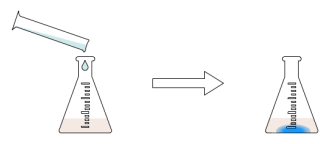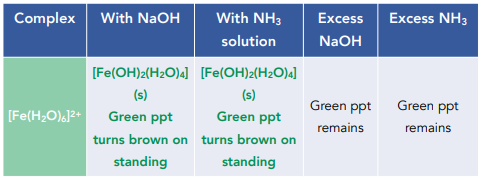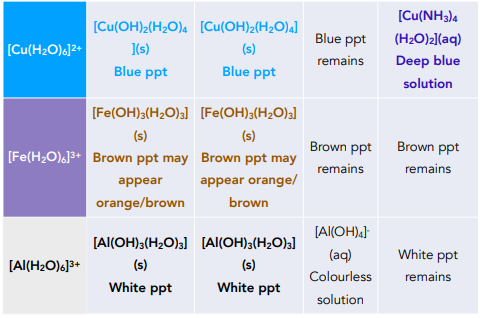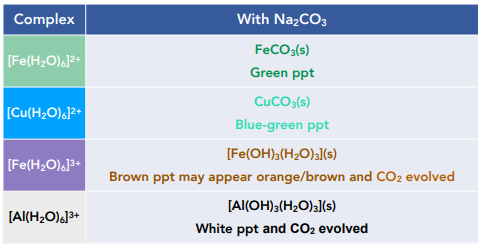Precipitation Reactions of Metal Ions in Solution (A-Level Chemistry)
Precipitation Reactions of Metal Ions in Solution
Reactions of M²⁺(aq) and M³⁺(aq) Metal-aqua Ions with alkalis
Addition of OH- ions to metal-aqua ions, by dilute sodium hydroxide (NaOH) or dilute ammonia (NH4), results in the formation of insoluble precipitates.

Addition of Limited OH- Ions to Cu²⁺and Fe²⁺Metal-Aqua Ions
When copper(II) ions are added to OH- ions, from dilute NaOH or dilute ammonia solution, the OH- ions remove a proton effectively from one of the water ligands.

OH- ions add to the complex formed to make a blue precipitate.

The reason a precipitate forms, is because the complex produced has no charge, i.e. it is neutral. This makes it insoluble in water.
The same type of reaction takes place with green iron(II)aqua ions.

The solution is initially pale green and upon adding ammonia or an alkali, a green iron (II) hydroxide precipitate forms. If left standing, the precipitate darkens and turns brown as Fe²⁺ ions become oxidised to Fe³⁺ by water and oxygen.
Addition of Limited OH- Ions to Fe³⁺ and Al³⁺ Metal-Aqua Ions
When iron (III) metal-aqua ions are added to dilute solutions of sodium hydroxide or dilute ammonia, similar reactions to the 2+ ions occur. However they produce one further hydrolysis reaction, as they are 3+ ions and not 2+ ions.
Iron (III) aqua ions are actually purple in solution, but may appear yellow due to some [Fe(OH)(H₂O)₅]²⁺(aq).
These ions are formed from hydrolysis reactions, produced as a result of the acidic nature of iron (III) metal-aqua ions.

A brown precipitate is formed, which may appear orange-brown.
Addition of Al³⁺ ions to hydroxide ions from dilute NaOH or ammonia solution, results in the formation of a white precipitate. The reactions are similar to those of iron (III) aqua ions.

Addition of excess NaOH to Metal-Aqua Cu²⁺ and Fe²⁺Ions
Addition of excess dilute hydroxide ions to metal-aqua Cu²⁺ and Fe²⁺ ions result in no further change, and the precipitates do not dissolve. However, addition of concentrated hydroxide ions results in further hydrolysis, producing negative ions, which are soluble, thus dissolving the precipitate.
Addition of excess Ammonia to Metal-Aqua Cu²⁺ and Fe²⁺Ions
Addition of excess dilute ammonia to the precipitate of [Fe(OH)₂(H₂O)₄] (s) results in no further change, and the precipitate does not dissolve.
However, with [Cu(OH)₂(H₂O)₄](s), ligand substitution reaction occurs. The blue precipitate dissolves and a deep blue solution is formed.
[Cu(OH)₂(H₂O)₄](s) + 4NH₃(aq) ⇌ [Cu(NH₃)₄(H₂O)₂](aq) + 2H₂O(l) + 2OH⁻ (aq)
Excess NaOH/NH₃ to Metal-Aqua Fe³⁺ and Al³⁺ Ions
Addition of excess dilute NaOH or excess ammonia to [Fe(OH)₃(H₂O)₃] (s) results in no change with either and the brown precipitate remains. With the white precipitate of [Al(OH)₃(H₂O)₃](s), however, it dissolves in excess NaOH solution, but the white precipitate remains with excess ammonia solution.
Amphoteric Nature of [Al(OH)₃(H₂O)₃](s)
[Al(OH)₃(H₂O)₃](s) is amphoteric as it reacts with both acids and alkalis. When excess dilute NaOH is added to the white precipitate of [Al(OH)₃(H₂O)₃](s), the precipitate dissolves to form a colourless solution.

When the white precipitate of [Al(OH)₃(H₂O)₃](s) reacts with acids, the metal-aqua complex is reformed. A colourless solution is formed.

Reactions of M²⁺ (aq) and M³⁺(aq) Metal-aqua Ions with Carbonate Ions
Reactions of Fe²⁺ and Cu²⁺ Ions with Carbonate Ions
[Cu(H₂O)₆]²⁺ (aq) and [Fe(H₂O)₆]²⁺ (aq) metal-aqua ions are slightly acidic. However, they are not acidic enough to evolve carbon dioxide gas from the carbonate. Instead a precipitate of the metal carbonate is produced.
With copper (II) metal-aqua ions, a blue-green precipitate is formed.

With iron (II) metal-aqua ions, a green precipitate is formed.

Reactions of Fe³⁺ and Al³⁺ Ions with Carbonate Ions
[Fe(H₂O)₆]³⁺(aq) and [Al(H₂O)₆]³⁺(aq) are both acidic enough to liberate carbon dioxide from a carbonate.
With [Fe(H₂O)₆]³⁺(aq), a brown precipitate is formed, which may appear orange-brown. Effervescence is produced as CO₂ gas is evolved.

With [Al(H₂O)₆]³⁺(aq), a white precipitate of [Al(OH)₃(H₂O)₃](s) is formed, with effervescence of carbon dioxide gas produced.
2[Al(H₂O)₆]³⁺(aq) + 2CO₃²⁻ →2 [Al(OH)₃(H₂O)₃](s) + 3CO₂(g) + 3H₂O(l)
Summary of Reactions of Ions in Aqueous Solutions



A precipitation reaction is a type of chemical reaction where two or more aqueous solutions are mixed together to form an insoluble solid, which separates from the solution as a precipitate.
Metal ions are positively charged particles of a metal element that are dissolved in a liquid solution. They can be formed by dissolving a metal compound in water or by chemical reactions.
Metal ions in solution react with other substances, such as anions or other metal ions, to form precipitates when the resulting compound is insoluble in the solution. This can happen because of changes in the oxidation state of the metal ions or the formation of complex ions.
Concentration plays a crucial role in precipitation reactions of metal ions in solution. If the concentration of one of the reactants is increased, the likelihood of a reaction taking place also increases. This is because there are more particles present in the solution, increasing the chances of collision and reaction.
The formation of precipitates in precipitation reactions of metal ions in solution can be prevented by adding a complexing agent, such as EDTA, to the solution. This will form a complex ion with the metal ion, preventing it from reacting with other substances and forming a precipitate.
Precipitation reactions of metal ions in solution are used in a variety of real-life applications, including the purification of water and the separation of metal ions in the field of analytical chemistry. They are also used in industries such as mining, where they are used to separate valuable metal ions from ore.
Precipitation reactions of metal ions in solution can impact the environment both positively and negatively. On one hand, they can be used to remove harmful pollutants from water sources. On the other hand, if the reaction conditions are not properly controlled, the formation of precipitates can lead to the release of toxic metal ions into the environment.






Still got a question? Leave a comment
Leave a comment